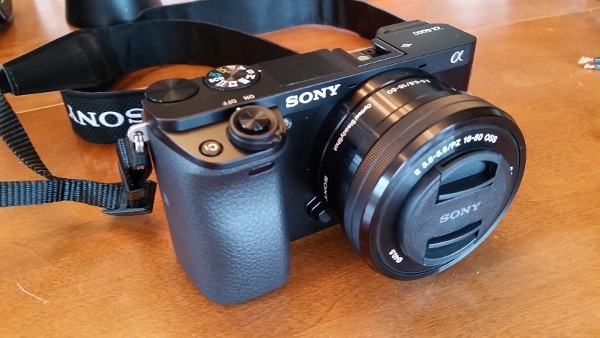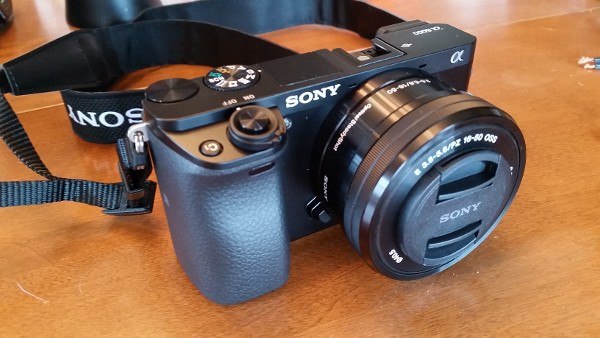Published by Jeremy. Last Updated on February 7, 2023.
Disclaimers: Our site uses demographic data, email opt-ins, display advertising, and affiliate links. Please check out our Terms and Conditions for more information. Listed prices and attraction details may have changed since our visit and initial publication.
There is no secret why the Sony a6000 mirrorless camera is the best camera for travel photography. It is small, powerful, and takes incredibly gorgeous photos for a price point that wont deter most photographers.
As I am someone who loves to rant on Sony cameras after having several point-and-shoot failures, and even once made a promise to never buy one again, I am voluntarily putting my foot in my mouth for buying another (and publishing this Sony a6000 review to publicly state my love for this camera).
Ignoring my misgivings against the point and shoots, I always stood by the fact that in terms of image quality, my HX20V and HX50V cameras were the best I ever had- possibly even beating my old SLR. So it should be no surprise that when I made the leap to mirrorless photography, I ended up buying the Sony a6000 despite my reservations.
It has been well over a year since that purchase, and I am not looking back- the Sony a6000 is worth the price.
If you are looking towards buying the same, especially if you are using the camera for travel photography, the following are the most important things you need to know.
✈️ Book Your Next Trip
- • Planning a trip? Find a flight deal.
- • In need of a room? Check out hotel and apartment prices.
- • Taking a cruise? Find a cruise itinerary for your journey.
- • Don't overlook picking up a rental car or day tours as well!
Sony a6000 Review – How is it Different from an SLR?
Now that I’ve owned a Nikon SLR and several Sony point & shoots, the first thing I should address is how they’re all different.
For the everyday photographer, the only major difference you’ll notice about the mirrorless cameras over their point & shoot counterparts is that they have interchangeable lenses. Getting past this, everything else on the a6000 is practically the same to the HX20V and HX50 models I mentioned before. This makes the camera very easy to pick up if you’re upgrading from a lower model like I was (however begrudgingly that may be).
The real difference comes when you compare the camera to an SLR as you have a powerful camera with all of the same manual settings in a body that is half the size and a fraction of the weight. Rather than having a swinging mirror for the shutter action, everything is digital and no mirror is necessary. Other than these two features, there really is very little that sets the two camera types apart.
Overall, I’m liking where the market is going for this, because if it is one thing travelers need, it is a smaller and lighter camera (because of course, that makes more room in our bags for lenses!).
- Note: The upcoming photos haven not been edited in Lightroom in any way shape or form. They are straight from the camera.
What About Functionality for the a6000?

If you’ve tried a Sony point & shoot in recent years, especially the HX20V and HX50V models, then the a6000 will be almost second nature to you.
The body is oriented just a bit differently, but otherwise the camera has all of the same features you’d expect. The manual controls, internal photo processing, premium features such as wifi integration with remote control and smart phone syncing, and gorgeous images are all what you’d come to expect from Sony’s cameras.
One of the new features that I really enjoy is the internal HDR setting which I am now using as a replacement for Paint mode (also included) which I previously used as an HDR substitute. You can see the difference HDR makes in the images below:
This mode takes three photos, one over-exposed and one under-exposed at increments from +/- 1 to 6. The camera then overlays the images internally and produces the finalized product while also saving a copy of the original as well (I take both now as a default because, why not?). The latter feature is quite important as it was one of my major complaints about Paint mode in the previous camera models. It doesn’t work so great when things are moving as ghosting appears, but for still images the final product requires little to no post-processing if you want an HDR image on the fly.

Other new features to me include a having an external and movable screen, a combo live-view / viewfinder, and a ultra-high-speed continuous shooting mode of up to 11 images per second.
A Few Items Missing in the a6000

On the downside front, I have noticed that a few of my favorite features from the HX20V and HX50V are missing from the a6000 mirrorless camera.
The first is the internal level display that illustrates if the camera’s body is off relative to the horizon. I’m not going to lose sleep over this functionality, but it seems a bit silly to remove such a simple thing that helps with composing images.
The second is the locking focus mechanism that was present on the point & shoot models. This method allowed you to pick a single point, lock on it, and then no matter how you moved the camera around the selected spot would stay in focus. I used this quite frequently to trick the light settings and am a bit disheartened that it is gone. The alternative mechanism is quite similar, but requires you to hold down the locking feature continuously which seems like a step in the wrong direction when a perfect alternative was available.
The third is that the zoom capabilities are now tied to the lens you choose. Sure, this is inherent to all mirrorless and SLR cameras, but those who have come to love the ridiculous zoom features of the HX20V or HX50V will have a hard time coming to terms with spending several hundred dollars on a lens that does the same thing. That being said, I’m in love with my 20mm prime f/2.8 and the kit lens isn’t awful either for those who don’t care about the minor details.
Finally, although my concerns over dust on the sensor is alleviated with the mirrorless camera’s cleaning capabilities (both internal and via external methods), the body construction is still a concern. A few of the buttons broke on one of our earlier models, and this camera uses the same setup. Luckily, the a6000 has several button combinations that achieve the same result, so if one does break there is likely an alternative access point unlike in its point & shoot counterparts.
Luckily for me, I am finally in a position where I can take advantage of buying long-term insurance, and you can be certain that as much as I love the camera, I won’t go without ever again.
Overall Sony a6000 Review – An Incredible Travel Camera

Ignoring a few minor details, the Sony a6000 camera alleviates many of the concerns I had with its point & shoot counterparts while packing in some pretty incredible options, controls, and post-processing capabilities that you simply do not have on other camera options.
If you are looking to use this for traveling, the compact body size is great both for your bag and for day-to-day explorations. The room (and weight!) you save then lets you pack in more lenses which, for the serious travel photographer, are what you often concern yourself with anyway.
SLR cameras, watch out. The mirrorless camera craze is just beginning, and travelers are taking note with the awesome Sony a6000!
Looking to Buy a Sony a6000? Here’s What You May Need
If you’re looking at buying a Sony a6000 camera (or the newer models Sony a63000 and Sony a65000) and need a good batch of associated equipment to get your camera arsenal started, the following items are what we personally use and recommend:
Have an existing blog that is in need of an upgrade? Check out the following services we personally use!
- BigScoots - Premium managed hosting with plans as low as $35/month.
- GeneratePress - A customizable theme designed for site speed.
- AdInserter Pro - A widget logic plugin that is quite powerful.
- WP Rocket - An image and caching optimization plug-in.
- Mailerlite - Cost effective newsletter service.
- Keysearch - Keyword research tool for SEO.
- Pretty Links Pro - A great link cloaking tool to clean up affiliate links.
- Sony a6000 Camera
- Sony 20mm Prime f/2.8 Lens (our preferred prime)
- Sony 16mm Prime f/2.8 Lens + 12mm UWA Adapter (read our full review of prime lenses here)
- Sony 24mm – 240mm f/3.5-f/6.3 (full frame compatible)
- BlackRapid Metro Strap
- Tripod
- 32 GB Memory Cards
- Camera Cleaning Kit
- Insurance Plan
About Jeremy

About the Author: Jeremy is a full-time travel writer based in Pittsburgh and primary author of this site. He has been to 70+ countries on five continents and seeks out new food, adventure activities, and off-the-beaten-path experiences wherever he travels.




A big drawback when traveling with the a6000 is no gps capability unless you use a geotagging program with your cell phone and upload it to the photos at a later time. Newer models include Bluetooth which does this automatically with your cell phone.
I love my a6000. I use it with a lot of manual focus lenses made for 35mm.
Adapters make this easy. I have Canon FD lenses, a lot of M42 mount lenses including some antiques, and some Pentax K mount lenses. You can thereby build a lens arsenal very cheaply buying second-hand manual lenses and the adapters for the Sony e-mount, giving you supreme flexibility and your images a unique look.
The adapters run around $20 and excellent-condition antique lenses go for $50 to $150 on ebay. I’ve even paid as little as $18 for a really wonderful telephoto Kiron lens (shipping was an additional $15).
You won’t get Autofocus, aperture, or lens info in the file information. And you will have to understand how light works by manually adjusting them. But you do get some really unique character in your photos.
The a6000 can still adjust the shutter and iso automatically even with a manual lens. So you can dial in the F-stop you want, focus the image, and let the camera adjust the other parameters to get the best exposure.
My favorite is a Super Takumar 55mm, which is about 83 mm in focal length on the APSC sensor of the a6000. Lenses made for 35mm cameras or full frame digital cast that same light on a smaller APSC sensor in the a6000 so you multiply the focal length of the lens by 1.5 to get the equivalent focal length in the Sony a6000.
Of course, there are plenty of auto focus lenses out there too including the ones made specifically for the Sony full frame cameras. They just cost a lot more. You can even adapt Autofocus lenses to the Sony from other brands, but those adapters have to transmit electrical signals so the “smart” adapters can run $200 or more.
The kit lens sold with the a6000 is mediocre at best. But it gets the job done and is quite compact. An antique lens, like the Jupiter 11 or Super Takumar, will get way more interesting light into the camera, often with sharper focus and truer colors. The stock lens is particularly bad at realistic skin tones, something a good portrait antique lens will easily blow away.
In the end, the flexibility of using manual lenses with inexpensive adapters renders a fun and not that challenging experience. After all, Autofocus isn’t perfect. Going manual teaches the user a lot about how photography actually works and can yield better results than just letting some programmed algorithm compose your shots.
But as a simple point and shoot, with everything automated, the Sony a6000 strikes a wonderful balance of advanced processing and low cost.